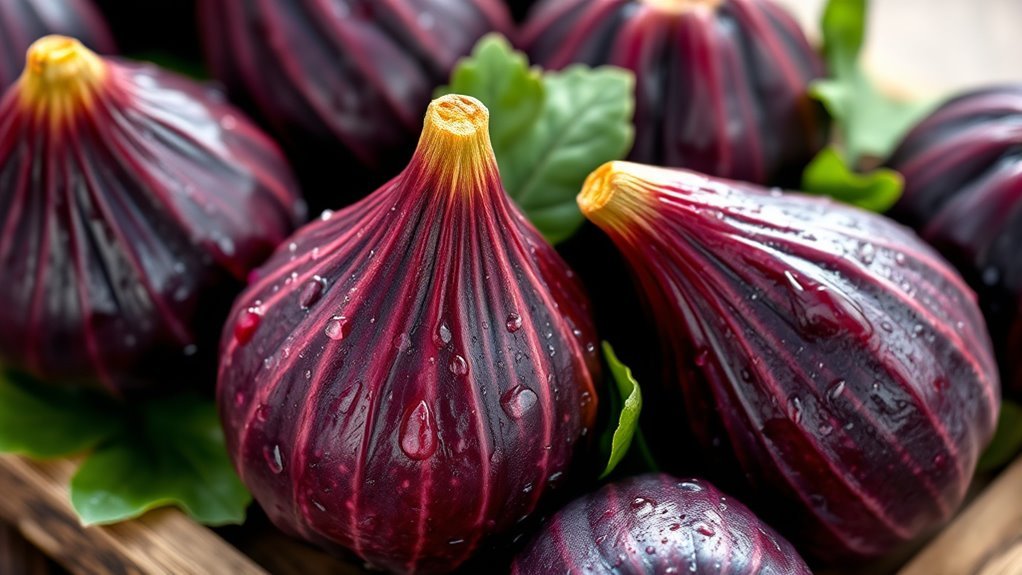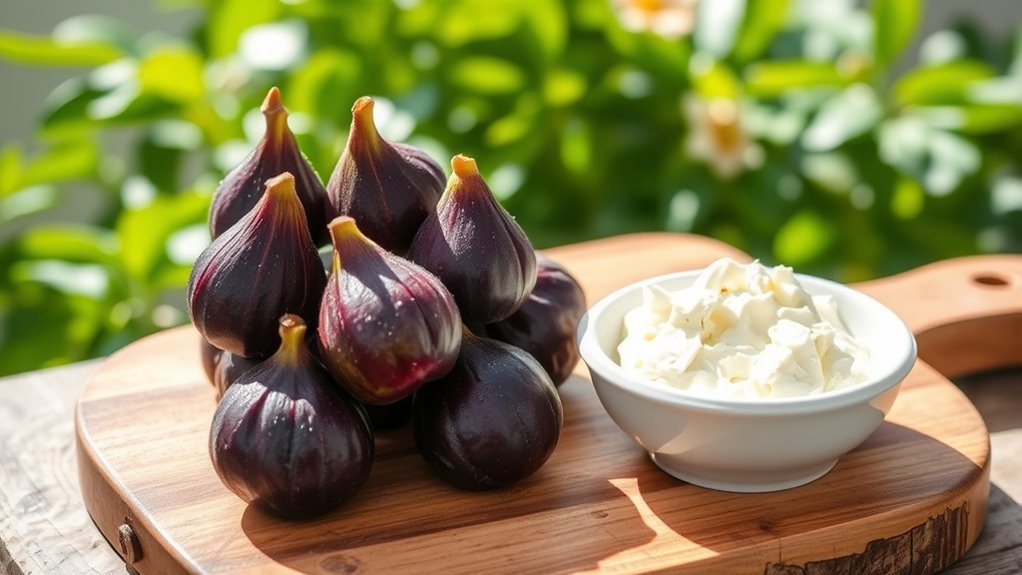Figs aren’t typically considered keto-friendly due to their high carbohydrate content, with one medium fig containing about 8 grams of carbs. While they offer various health benefits and nutrients, you’ll need to practice portion control to fit them into your ketogenic diet. Consuming one or two figs can help maintain your daily carb limits, but it’s wise to explore more keto-compatible fruits as well. Keep exploring for more insights on balancing figs and keto.
Understanding the Ketogenic Diet

The ketogenic diet, often known as keto, is a high-fat, low-carbohydrate eating plan designed to shift your body’s metabolism from burning glucose to burning fat for energy. At its core, the ketogenic principles focus on drastically reducing carbs while increasing fat intake. This change encourages your body to enter a state called ketosis, where it becomes proficient at fat adaptation. Once adapted, your body efficiently uses fat as its primary energy source, which can lead to weight loss and improved mental clarity. By embracing this lifestyle, you’re not just restricting calories; you’re fundamentally changing how your body processes nutrients. This freedom from sugar dependency can empower you to make healthier choices, fueling your body in a way that aligns with your goals.
Nutritional Profile of Figs

When considering figs in your diet, it’s important to look at their carbohydrate content, which can impact your keto goals. These fruits contain a notable amount of sugar and fiber, influencing their overall nutritional profile. Understanding these elements can help you make informed choices about including figs in a low-carb lifestyle.
Carbohydrate Content Overview
Although figs are often celebrated for their unique flavor and health benefits, their carbohydrate content can be a concern for those following a keto diet. One medium fig contains around 8 grams of carbohydrates, making it essential to take into account portion sizes. While figs offer some fiber content, which is beneficial for digestion, the sugar content can limit their appeal as a keto-friendly option. If you’re looking for sugar alternatives, keep in mind that figs may not fit seamlessly into your lifestyle.
| Serving Size | Carbohydrates (g) | Fiber Content (g) |
|---|---|---|
| 1 Medium Fig | 8 | 1.4 |
| 5 Medium Figs | 40 | 7 |
| 1 Cup Sliced | 37 | 5.5 |
| 1 Dried Fig | 20 | 1.4 |
| 1 Fig Roll | 22 | 1 |
Fiber and Sugar Levels
While figs are delicious and packed with nutrients, their fiber and sugar levels can play a significant role in your dietary choices. Figs are high in dietary fiber, offering about 3 grams per medium fruit, which can support digestion and promote satiety—two key fiber benefits. However, they also contain a notable amount of natural sugars, with roughly 8 grams per medium fig. This sugar impact can affect blood sugar levels, especially for those following a keto diet. If you’re aiming to minimize sugar intake, you might want to be mindful of portion sizes. Ultimately, enjoying figs in moderation can provide you with the nutritional benefits while keeping your dietary goals in check.
Carbohydrate Content in Figs

When considering figs, it’s important to look at their carbohydrate content, as this directly impacts your keto diet. A typical serving of figs contains a significant amount of carbs, which can make it challenging to fit them into a low-carb lifestyle. Understanding the nutritional breakdown of figs will help you make informed choices about their inclusion in your meals.
Nutritional Breakdown of Figs
Figs are often praised for their unique taste and health benefits, but if you’re considering them for a keto diet, it’s essential to look closely at their nutritional profile, particularly their carbohydrate content. Fresh figs contain about 27 grams of carbohydrates per 100 grams, while dried figs can have upwards of 75 grams. This high carb count can be challenging for maintaining ketosis. Different fig varieties, like Black Mission or Kadota, may vary slightly in nutritional content, but the carbohydrate levels remain significant. If you’re keen on experimenting, consider incorporating figs into low-carb recipes sparingly, balancing their sweetness with other keto-friendly ingredients. Ultimately, moderation is key in enjoying figs without derailing your keto goals.
Impact on Keto Diet
The significant carbohydrate content in figs can pose a challenge for those on a keto diet. Each medium fig contains about 8 grams of carbs, which can quickly add up and hinder your daily carb limit. While figs offer numerous benefits, such as high fiber content and rich antioxidants, their natural sugars may outweigh these advantages for keto followers. You might enjoy their sweetness, but it’s essential to be aware of the potential drawbacks. If you’re craving figs, consider consuming them in moderation, perhaps as part of a low-carb meal. Ultimately, balancing figs benefits with their carbohydrate load can help you maintain your keto lifestyle without feeling deprived. Enjoying them occasionally can keep your diet flexible and satisfying.
Comparing Figs to Other Fruits
While many fruits offer a variety of health benefits, it is essential to compare their nutritional profiles to understand how figs stack up against them, especially for those following a ketogenic diet. When you look at fig varieties, such as Black Mission or Kadota, their carbohydrate content can be higher than other low-carb options like berries. For instance, a serving of figs contains about 8 grams of carbs, whereas raspberries boast only 7 grams. Fruit comparisons reveal that while figs are rich in fiber and essential nutrients, their higher sugar content may not align with strict keto guidelines. If you’re aiming for a low-carb lifestyle, you might want to limit your fig intake and focus on more keto-friendly fruits instead.
Health Benefits of Figs
Although you might need to be cautious about their carb content on a keto diet, figs offer a range of impressive health benefits. Rich in nutrient density, these fruits are packed with vitamins, minerals, and dietary fiber. They support digestive health, helping to prevent constipation and promote a healthy gut. Figs also boast antioxidant properties, which can help combat oxidative stress and reduce the risk of chronic diseases. Additionally, their potassium content aids in regulating blood pressure, contributing to heart health. Including figs in your diet can enhance your overall nutritional intake, providing a flavorful option for those seeking a balanced approach to wellness. Just remember to enjoy them in moderation!
Can Figs Fit Into a Low-Carb Diet?
Figs can be a tricky addition to a low-carb diet, especially given their natural sweetness and relatively high carbohydrate content. While some fig varieties may fit into your meal plan, it’s important to evaluate portion sizes and how you store them to maintain freshness. Here’s a quick comparison:
| Fig Varieties | Carbohydrates (per 100g) |
|---|---|
| Black Mission | 19g |
| Kadota | 26g |
| Adriatic | 24g |
| Brown Turkey | 22g |
| Calimyrna | 27g |
If you decide to include figs, reflect on how you’ll incorporate them wisely while keeping an eye on your overall carb intake. Proper fig storage can also help you enjoy their unique flavors longer.
Portion Control and Figs
When it comes to enjoying figs on a keto diet, serving sizes truly matter. A few figs can add valuable nutrients, but their carbohydrate content can quickly add up, affecting your daily limits. Balancing your intake is essential to stay within your carbohydrate goals while still enjoying this delicious fruit.
Serving Sizes Matter
While many people enjoy the sweet, chewy texture of figs, it’s important to be mindful of portion sizes, especially on a keto diet. Different fig varieties have varying carbohydrate content, so knowing how much you’re eating can help you stay within your limits. For instance, a serving of fresh figs typically contains around 8-10 grams of carbs, which can quickly add up. Implementing serving strategies, like limiting yourself to one or two figs, helps maintain balance. You might also consider pairing figs with healthy fats, such as cheese or nuts, to enhance satiety. By practicing portion control, you can enjoy the delightful taste of figs without jeopardizing your keto goals. Remember, moderation is key!
Balancing Carbohydrate Intake
Maintaining a keto diet requires careful management of carbohydrate intake, and this is where portion control becomes particularly important with fruits like figs. While figs offer various health benefits, they are higher in carbohydrates compared to many other fruits. To achieve carbohydrate balance, it is crucial to incorporate figs mindfully within your dietary strategies. Consider limiting your intake to a small serving, such as one or two figs, to avoid exceeding your daily carb limit. This way, you can enjoy the unique taste and nutrients of figs without derailing your keto goals. Remember, the key is moderation—by practicing portion control, you can savor the freedom of including figs in your diet while still staying aligned with your health objectives.
Alternative Fruits for a Keto Diet
If you’re following a keto diet, you might be wondering which fruits can fit into your low-carb lifestyle. While figs are often too high in carbs, there are plenty of keto-friendly alternatives. Consider incorporating keto-friendly berries like strawberries, raspberries, and blackberries. These fruits are not only low in carbs but also packed with antioxidants and vitamins. You can enjoy them in moderation without derailing your diet. Other low-carb alternatives include avocados, which provide healthy fats, and olives, which are great for snacking. Remember, the key is to check the carb counts and portion sizes. By choosing these options, you can satisfy your sweet cravings while staying true to your keto goals. Enjoy the freedom of variety!
Recipes Incorporating Figs
Although figs may not be the best choice for a strict keto diet, they can still be enjoyed in moderation when incorporated into recipes that balance their natural sweetness with low-carb ingredients. For a delightful treat, consider making fig-based desserts like almond flour fig muffins or a low-carb fig tart using a coconut flour crust. These options allow you to savor figs without going overboard on carbs.
For a savory twist, try fig appetizer ideas such as prosciutto-wrapped figs or a fig and goat cheese salad. Pairing figs with proteins and healthy fats can create a satisfying balance, making them a versatile ingredient in your keto-friendly meal prep. Enjoy experimenting with these recipes while maintaining your dietary goals!
Final Thoughts on Figs and Keto
When evaluating the role of figs in a keto diet, it’s important to weigh their nutritional profile against your personal dietary goals. While figs can offer some health benefits, they’re relatively high in carbohydrates, which may not align with your ketogenic objectives.
Here are some key points to reflect upon:
- Fig Varieties: Different types, like Black Mission and Kadota, have varying carb counts.
- Fig Benefits: Rich in fiber, antioxidants, and essential vitamins.
- Portion Control: Moderation is essential; a small serving might fit your macros.
- Personal Goals: Assess how figs align with your overall health and fitness targets.
Ultimately, you’ll need to decide if the fig benefits outweigh the carb content for your keto lifestyle.
Frequently Asked Questions
Can Dried Figs Be Included in a Keto Diet?
Dried figs can be tricky on a keto diet. While they offer nutritional benefits like fiber, vitamins, and antioxidants, they’re also high in natural sugars and carbs. If you want to include them, it’s best to limit your serving size and pair them with healthy fats, like nuts or cheese, to balance blood sugar levels. Consider using them as an occasional treat rather than a staple to maintain your keto goals.
Are There Any Keto-Friendly Fig Substitutes?
If you’re searching for keto-friendly fig substitutes, you’re in luck! Low carb fruits like raspberries, blackberries, and strawberries can satisfy that sweet craving without derailing your diet. These fig alternatives are not only delicious but packed with vitamins. You might also consider unsweetened coconut or even a bit of stevia for sweetness. Just remember, keeping your carb count low is key, so enjoy these options while maintaining your keto goals!
How Do Figs Affect Blood Sugar Levels?
Figs can have a moderate glycemic impact, which means they can raise blood sugar levels, but their fiber content helps slow down sugar absorption. If you’re mindful of blood sugar regulation, enjoying figs in moderation can be beneficial. They provide vitamins and minerals, but it’s important to balance your intake with other low-glycemic foods to maintain stable levels. Always pay attention to your body’s response when incorporating figs into your diet.
Can I Eat Figs on a Strict Ketogenic Diet?
You can eat figs on a strict ketogenic diet, but moderation’s key. While they offer nutritional benefits like fiber and antioxidants, their higher carbohydrate content may hinder your ketosis goals. If you choose to include figs, consider how they fit into your daily carb allowance. Balancing your intake with other low-carb foods can help you enjoy the flavor of figs while adhering to keto diet considerations.
What Is the Best Time to Consume Figs on Keto?
The best time to consume figs on keto is during meals when you can pair them with healthy fats or proteins, like in a salad or with cheese. This fig consumption timing helps balance their natural sugars and supports your ketosis. Incorporating figs in moderation can add flavor and variety while still adhering to your diet. Just keep an eye on your overall carb intake to maintain your desired keto lifestyle!


